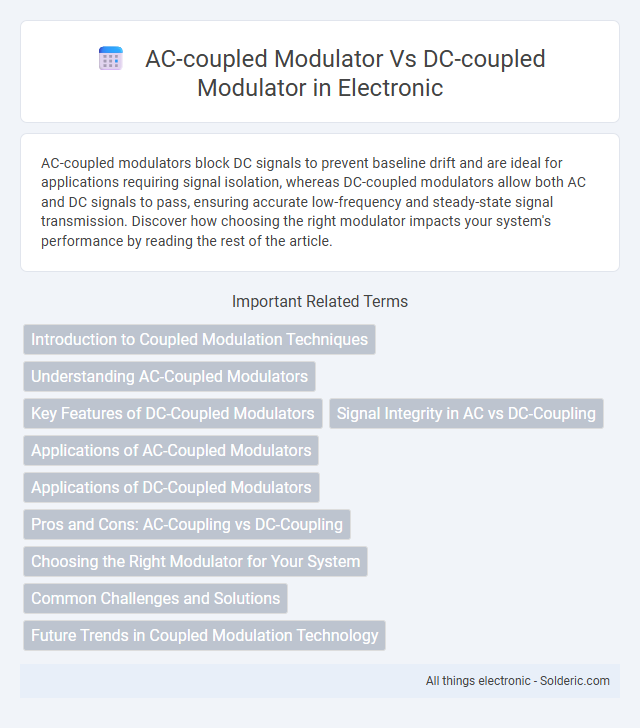AC-coupled modulators block DC signals to prevent baseline drift and are ideal for applications requiring signal isolation, whereas DC-coupled modulators allow both AC and DC signals to pass, ensuring accurate low-frequency and steady-state signal transmission. Discover how choosing the right modulator impacts your system's performance by reading the rest of the article.
Comparison Table
| Feature | AC-Coupled Modulator | DC-Coupled Modulator |
|---|---|---|
| Coupling Type | Alternating Current (AC) | Direct Current (DC) |
| Signal Transmission | Blocks DC component; passes AC signals only | Passes both AC and DC components |
| Baseline Stability | Requires baseline restoration; susceptible to baseline wander | Stable baseline with no wander |
| Offset Voltage | Removes DC offset; no direct offset accumulation | May introduce DC offset; needs offset correction |
| Applications | High-frequency RF modulation; optical modulators needing AC signals | Low-frequency and DC accurate modulation; precision analog signals |
| Complexity | Simpler circuit; fewer biasing components | More complex biasing and stabilization needed |
| Power Consumption | Generally lower due to simpler design | Can be higher due to bias circuits |
| Signal Distortion | Possible distortion due to capacitive coupling | Minimal distortion with direct coupling |
Introduction to Coupled Modulation Techniques
AC-coupled modulators use capacitive coupling to block DC components, enabling signal transmission without baseline drift and reducing low-frequency noise in communication systems. DC-coupled modulators maintain a continuous conductive path, allowing direct current flow and preserving signal integrity for applications requiring precise voltage control and faster response times. Understanding the differences between AC and DC coupling techniques is essential for optimizing modulation performance based on signal characteristics and system requirements.
Understanding AC-Coupled Modulators
AC-coupled modulators use capacitors to block DC components, allowing only AC signals to pass through, which helps prevent DC offset issues in high-frequency communication systems. Your choice of an AC-coupled modulator improves signal integrity in environments sensitive to baseline drift or where the modulator interfaces with components having different operating voltage levels. This design enhances performance in optical and radio frequency applications by minimizing distortion and preserving signal quality.
Key Features of DC-Coupled Modulators
DC-coupled modulators provide a direct electrical connection between the input and output, enabling accurate low-frequency and DC signal modulation without distortion or baseline drift. These modulators offer precise control over the signal amplitude and phase, making them ideal for applications requiring stable, low-frequency performance and wide dynamic range, such as in advanced optical communication systems. Your system benefits from improved signal fidelity and simplified bias control when using DC-coupled modulators compared to their AC-coupled counterparts.
Signal Integrity in AC vs DC-Coupling
AC-coupled modulators improve signal integrity by blocking DC offsets and low-frequency noise, which reduces baseline wander and prevents signal distortion in high-speed communication systems. DC-coupled modulators maintain the signal's baseline, preserving low-frequency components crucial for applications requiring accurate amplitude and phase information, but they may suffer from baseline drift and increased susceptibility to noise. Selecting between AC and DC coupling depends on the application's tolerance for low-frequency signal components and the need for stable voltage references in modulator design.
Applications of AC-Coupled Modulators
AC-coupled modulators are widely used in high-frequency communication systems where signal distortion from DC offsets needs to be minimized, such as in RF and microwave signal processing. These modulators excel in optical communication applications for dynamic signal modulation without baseline wander or low-frequency interference. Their ability to block DC components makes them ideal for systems requiring isolation between source and load, enhancing performance in fiber optic transceivers and advanced radar systems.
Applications of DC-Coupled Modulators
DC-coupled modulators are widely used in applications requiring precise control of low-frequency or near-DC signals, such as in analog signal processing, bioelectronics, and sensor interfacing. Their ability to handle zero-frequency components without distortion makes them ideal for direct modulation in communication systems and instrumentation amplifiers. Your projects involving long-duration or slowly varying signals benefit significantly from the steady, drift-free performance of DC-coupled modulators.
Pros and Cons: AC-Coupling vs DC-Coupling
AC-coupled modulators block DC components, reducing low-frequency noise and preventing drift issues, but may cause baseline wander and slow response to low-frequency signals. DC-coupled modulators allow accurate transmission of both low and high-frequency signals without distortion but are more prone to DC offset and require careful biasing to avoid signal degradation. Your choice depends on the application's sensitivity to low-frequency response versus stability and noise considerations.
Choosing the Right Modulator for Your System
AC-coupled modulators block DC components, making them ideal for systems sensitive to DC offsets or requiring isolation from low-frequency noise, whereas DC-coupled modulators transmit both AC and DC signals, providing accurate representation of input signals including slow varying or static components. Selecting the right modulator depends on application requirements such as bandwidth, signal integrity, and compatibility with downstream electronics, with AC coupling preferred for high-speed data transmission and DC coupling favored for precise analog signal processing. Considerations like power consumption, signal distortion, and system architecture dictate whether an AC-coupled or DC-coupled modulator best fits the specific operational environment.
Common Challenges and Solutions
AC-coupled modulators often face baseline drift and signal distortion due to capacitive coupling, requiring high-pass filtering and periodic calibration to maintain signal integrity. DC-coupled modulators eliminate baseline wander but can experience offset voltage issues and thermal drift, necessitating precise offset compensation and temperature stabilization techniques. Both modulators benefit from advanced digital signal processing algorithms to mitigate noise and improve linearity in optical communication systems.
Future Trends in Coupled Modulation Technology
Future trends in coupled modulation technology emphasize enhanced bandwidth and power efficiency, with AC-coupled modulators improving signal integrity by blocking DC offsets, making them ideal for high-speed data transmission. DC-coupled modulators offer direct signal coupling that supports low-frequency and DC signal processing, essential for evolving applications in precision sensing and advanced communication systems. Your choice between AC and DC coupling will increasingly depend on the specific demands of emerging IoT devices and 5G/6G infrastructure developments.
AC-coupled modulator vs DC-coupled modulator Infographic

 solderic.com
solderic.com